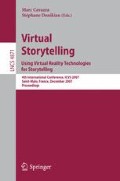Abstract
Thanks to the technological advances in the last ten years, the recreation of 3D virtual worlds is becoming increasingly popular in several application fields. Desktop virtual reality is one of the best ways of reaching a good number of users through this technology. With the aim of improving the development of desktop virtual reality applications and increasing the relevance of the virtual experience, we defined the Virtual Reality Framework (VRF). This framework supports the creation of interactive systems for personalized and group guided tours in virtual worlds. The VRF can incorporate functionalities including context-sensitive information that a virtual guide will tell a user or group of users in a personalized manner. User interaction with the environment and with the intelligent virtual guides will lead to changes in the story told during the tour. In this paper we describe the Virtual Alhambra Project, which was the project that brought the VRF into being.
Access this chapter
Tax calculation will be finalised at checkout
Purchases are for personal use only
Preview
Unable to display preview. Download preview PDF.
References
Active Worlds: Home of 3D Chat, Virtual Reality Building Platform (2007), http://www.activeworld.com
Louvre: Another Way to Visit the Louvre. Virtual Tours (2007), http://www.louvre.fr/llv/muse/visite_virtuelle.jsp?bmLocale=en
Second Life: What is Second Life? (2007), http://secondlife.com/whatis
Djajadiningrat, J.P., Overbeeke, C.J., Wensveen, S.A.G.: Augmenting Fun And Beauty: A Pamphlet. In: DARE 2000. Proc. Designing Augmented Reality Environments, ACM Press, New York (2000)
Löckelt, M.: Action Planning for Virtual Human Performances. In: Subsol, G. (ed.) Virtual Storytelling. LNCS, vol. 3805, pp. 53–62. Springer, Heidelberg (2005)
Swartout, W., Hill, R., Gratch, J., Johnson, W.L., Kyriakakis, C., LaBore, C., Lindheim, R., Marsella, S., Miraglia, D., Moore, B., Morie, J., Rickel, J., Thiebaux, M., Tuch, L., Whitney, R., Douglas, J.: Toward the Holodeck: Integrating Graphics, Sound, Character and Story. In: Proc. Autonomous Agents Conference (2001)
Young, R.M.: Creating Interactive Narrative Structures: The Potential for AI Approaches. In: Proc. AAAI Spring Symposium in Artificial Intelligence and Interactive Entertainment, AAAI Press (2000)
Tarau, P., Figa, E.: Knowledge-based conversational agents and virtual storytelling. In: Proc. 2004 ACM symposium on Applied computing, Nicosia, Cyprus, pp. 39–44 (2004)
Abawi, F., Reinhold, S., Dšrner, R.: A Toolkit for Authoring Non-linear Storytelling Environments Using Mixed Reality. In: Göbel, S., Spierling, U., Hoffmann, A., Iurgel, I., Schneider, O., Dechau, J., Feix, A. (eds.) TIDSE 2004. LNCS, vol. 3105, pp. 113–118. Springer, Heidelberg (2004)
Theune, M., Faas, S., Heylen, D.K.J., Nijholt, A.: The virtual storyteller: Story creation by intelligent agents. In: Göbel, S., Braun, N., Spierling, U., Dechau, J., Diener, H. (eds.) Technologies for Interactive Digital Storytelling and Entertainment, pp. 204–215. Fraunhofer IRB Verlag, Darmstadt (2003)
Cavazza, M., Pizzi, D.: Narratology for Interactive Storytelling: a Critical Introduction. In: Proc. 3rd International Conference on Technologies for Interactive Digital Storytelling and Entertainment, Darmstadt, Germany (2006)
Fuertes, J.L, González, Á.L., Mariscal, G., Ruiz, C.: Aplicación de la Realidad Virtual a la difusión de la cultura: La Alhambra Virtual. In: INTERACCION 2005. Proc. VI Congreso de Interacción Persona Ordenador (AIPO), Granada, pp. 367–371 (2005)
AndalucíaWeb: La Alhambra de Granada. El monumento más visitado de España (2007), http://www.andalucia-web.net/alhambra_infos.htm
ArsVirtual: Espacio Virtual para la Difusión del Patrimonio Cultural. La Alhambra de Granada (2007), http://www.arsvirtual.com/p_espagnol/visitas_virtuales/otros_monumentos/alhambra/alhambra01.jsp
Reilly, P., Lockyear, K., Rahtz, S.: Towards a Virtual Archaeology. In: CAA 1990. Computer Applications and Quantitative Methods in Archaeology. BAR International Series, vol. 565, pp. 133–139. Tempvs Reparatvm, Oxford (1990)
Hoorn, J.F., Konijn, E.A., Van der Veer, G.C.: Virtual reality: Do not augment realism, augment relevance. Upgrade - Human-Computer Interaction: Overcoming Barriers 4(1), 18–26 (2003)
Wooldrige, M., Jennings, N.R.: Intelligent Agents: Theory and Practice. Knowledge Engineering Review 10(2), 115–152 (1995)
Habbo Hotel: Habbo (2005), http://www.habbo.com
Donikian, S., Portugal, J.-N.: Writing Interactive Fiction Scenarii with DraMachina. In: Göbel, S., Spierling, U., Hoffmann, A., Iurgel, I., Schneider, O., Dechau, J., Feix, A. (eds.) TIDSE 2004. LNCS, vol. 3105, pp. 101–112. Springer, Heidelberg (2004)
Göbel, S., Feix, A.: MuViPlan: Interactive Authoring Environment to Plan Individual Museum Visits. In: Trant, J., Bearman, D. (eds.) Proc. Museums and the Web 2005, Archives & Museum Informatics, Toronto (2005)
Flor, L., Fuertes, J.L., González, Á.L., Varela, J.I.: The “Activities Exhibitor”: A way to build self-adapting tutoring systems. In: Proc. Third World Multiconference on Systemics, Cybernetics and Informatics (SCI 1999) and Fifth International Conference on Information Systems Analysis and Synthesis (ISAS 1999), pp. 379–386 (1999)
Frutos, S., González, Á.L., Martínez, L., Montes, C.: Adapting Computer-Human Interaction in Real Time. In: Proc. IEEE International Conference on Systems, Man and Cybernetics, pp. 1038–1043 (1998)
González, Á.L.: Modelo para la Generación y Gestión en Tiempo de Ejecución de Procesos de Interacción Hombre-Máquina a Partir de un Lenguaje de Especificación de Relaciones con el Usuario. PhD Thesis dissertation, School of Computing, Technical University of Madrid (2003)
Puerta, A., Eisenstein, J.: Towards a General Computational Framework for Model-Based Interface Development Systems. In: IUI 1999. Proc. International Conference on Intelligent User Interfaces, pp. 171–178. ACM Press, New York (1999)
Gudmundson, A.: LERUX: An XML-based language for user interface specification. Master Thesis, Technical University of Madrid (2004)
Hammerton, J., Osborne, M., Armstrong, S., Daelemans, W.: Introduction to Special Issue on Machine Learning Approaches to Shallow Parsing. JMLR Special Issue on Shallow Parsing 2(3), 551–558 (2001)
Author information
Authors and Affiliations
Editor information
Rights and permissions
Copyright information
© 2007 Springer-Verlag Berlin Heidelberg
About this paper
Cite this paper
Fuertes, J.L., González, Á.L., Mariscal, G., Ruiz, C. (2007). Developing Virtual Storytellers for the Virtual Alhambra. In: Cavazza, M., Donikian, S. (eds) Virtual Storytelling. Using Virtual Reality Technologies for Storytelling. ICVS 2007. Lecture Notes in Computer Science, vol 4871. Springer, Berlin, Heidelberg. https://doi.org/10.1007/978-3-540-77039-8_6
Download citation
DOI: https://doi.org/10.1007/978-3-540-77039-8_6
Publisher Name: Springer, Berlin, Heidelberg
Print ISBN: 978-3-540-77037-4
Online ISBN: 978-3-540-77039-8
eBook Packages: Computer ScienceComputer Science (R0)

